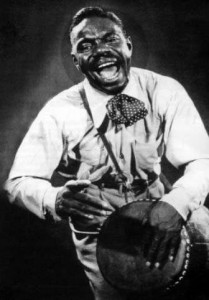
Updated to fix links.
Another obituary in the news today that provides a glimpse into the fascinating history of postwar new York City. The great New York rumbero Totico has died.
Totico, who was born in Cuba, didn’t arrive in New York until 1959. But his path through life and his role in sparking a revival of rumba music in New York reflects a larger interesting history–which is the way Cuban music became part of New York life in the decades after the war. The music travelled to the Big Apple (so named by jazz musicians in the 20s, btw) with professional musicians who worked in the flourishing entertainment industry of the War years, but it also flourished on the conditions created by the arrival of Cuban and especially Puerto Rican imigrants. They came to the city in large numbers during the ’40s, later to be joined in subsequent migrations by arrivals from the Dominican Republic, Haiti, and other locations throughout the Carribbean and Latin America. New York City was a predominantly white city in 1940, with a large population of descendents of immigrants from Eastern and Southern Europe. By the end of the decade, the arrival of large numbers of African-Americans from the U.S. South and of Puerto Ricans, alongside the growing outmigration of whites to the new suburbs, had remade the city’s ethic profile.
These migrations led to great changes in the cultural, as well as the social and political, life of New York City. Notice that New York City’s new Puerto Rican community is not really on E.B. White’s radar at all. Anatole Broyard, on the other hand, was a habitue of East Harlem dance halls, where he was admired for his dancing and good looks, and he talks, in a passage of his memoir that we didn’t read, about bringing Greenwich Village intellectuals uptown to marvel at a world that seemed to them entirely foreign. By the 1950s and 1960s, New York’s Latinidad would be a widely recognizable feature–marked in music, movies, and television–of the city’s identity.
The variety of Cuban and Puerto Rican musics that migrants brought to New York in the ’40s, ’50s , and ’60s eventually merged to form the distinctly New-York-City genre known as “salsa.” During the late ’40s, however, an earlier combination of Cuban music and American swing produced first “Latin American jazz” and then the mambo craze. The mambo phenomenon began in the last years of the ’40s but really took off in the 50s, especially at New York’s Palladium night club–then located on West 53rd Street. (A later celebrated nighclub by the same name would open on East 14th St. in the 1980s.)
There’s great footage of mambo dancing at the Palladium in this YouTube video , along with a brief history of the nightculb, though you have to wait past the introductory few minutes.
The most influential early creations in Latin Jazz came when the Cuban conga player Chano Pozo joined Dizzy Gillespie’s band and helped Gillespie create the seminal songs “Cubana Be, Cubana Bop” and “Manteca.”
But there were other important and fascinating people on the New York music scene at the time who helped import rhythms and musical and dance styles from Cuba into American jazz and pop. Some of the big names: Mario Bauza, Xavier Cugat, and, especially, Machito (YouTube). Later Tito Puente and others. A rich musical and cultural history.
